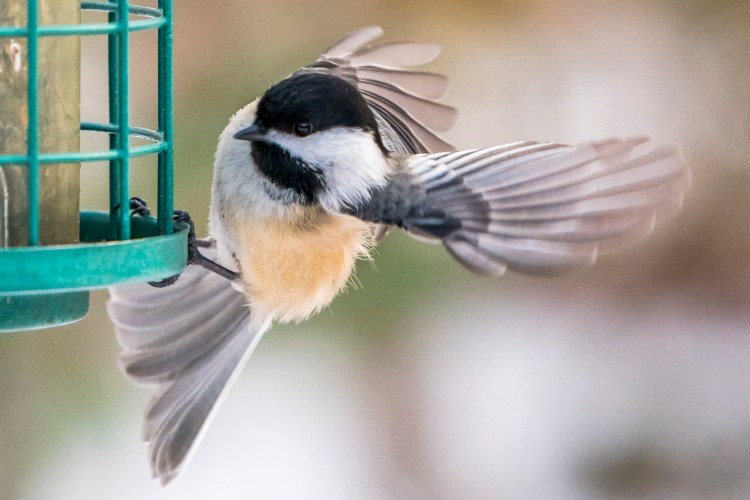Since it started looking like snowbanks were actually shrinking a week or two ago, I’ve lost count of the avian signs of new life.
By remaining casually alert, we’ve seen, in no particular order or quantity: robins, ubiquitous crows and gulls, a great blue heron overflying the car, assorted fleeting starlings and blackbirds, mourning doves, black-capped chickadees, a huge hawk — maybe red-tailed — tearing apart a meal she’d balanced on a fallen tree just into the woods, ducks in sortie formation, skedaddling blue jays, some oingo-boingo juncos, and a big fat red-winged blackbird. On the feeder at my sister’s house in Farmington, more chickadees and a titmouse, and in their backyard brush a bird we had a lot of trouble figuring out because of misdirective reddish coloring on the neck and tail feathers — we matched it unconfidently by size and other characteristics to a northern shrike. Back in Troy, Canada geese honking cheerfully overhead. Sounding cheerful, anyway. I heard a song sparrow in the Unity park.
Also, the phoebes are back.
In the beginning is their song, every April, coming from the birches outside the bathroom window, “fee-bee.” This year it was an unusually full-throated, almost husky-sounding call whose origin at first I doubted. But within seconds of peering into the still-skeletal April foliage, there, sure enough, was the little gray bird perched in the Bebb willow, tail wagging up and down. Excited, we presume, to be back at the summer home, which is a mud nest tucked up under the eave.
The birds, in sort of dwindling local abundance, it seems, from year to year, don’t exactly fill the woods with music anymore. But the black-capped chickadees’ two-note tune and the squawks, twitters and hoots that rise after silent winter make it seem like everybody’s living in songs after all. Perennially we ask: What are they saying? Because, like J.R.R. Tolkien’s elves, we would like to talk to everything, and because most of our answers are speculations.
Some wildlife biologists argue that birds have cultures, which are identified by changes groups of birds learn to make in, for example, foraging techniques or singing. The singing in particular seems to be a matter of disagreement among ornithologists. It is well-documented that bird calls have fairly particular meanings within species — the male chickadee’s two-note tune marks his territory, and woodpeckers’ drumming sends mating and territorial messages. Birds learn songs from their families and groups, and “local dialects” of songs can develop from area to area, indicating they modify the tunes — to largely unknown purposes. Learned aspects of songs can affect female mating preferences in some birds.
But what singing tells about the birds themselves is uncertain. It has been hypothesized that the relative complexity of a song serves as a measure of a male’s suitability as a mate — in other words, females might judge the quality of a male by the quality of his more difficult tunes. But some studies show this is not the case.
Another hypothesis is that song characteristics indicate a bird’s cognitive abilities. But a recent study of swamp sparrows showed no correlation between the quality of a male’s song and what we might refer to as his overall intelligence. The researchers devised ways to measure each bird’s repertoire size, vocal performance and song learning, and compared those measures to how quickly each bird mastered cognitive tasks such as a new foraging technique, color associations and spatial tests such as detours. The song quality indicated nothing about the bird’s intelligence in these other areas.
Why this should be surprising, I’m not sure. I’ve known musicians who could not change a tire or make it all the way through a three-step philosophical syllogism, but could tear your heart out with their voice or guitar.
What the word “quality” means in this context is uncertain. The wildlife scientists use it, but they calculate it by quantities. I know music is mathematical in its bones. But its deep heart’s core has less to do with counting out rhymes than hearing them swell in your ears. Like April birdsong.
I don’t know. I only know the birds are back. Spring is being reinvented, again. It all sounds like excitement to me.
Dana Wilde lives in Troy. You can contact him at naturalist1@dwildepress.net. His recent book is “Summer to Fall: Notes and Numina from the Maine Woods,” available from North Country Press. Backyard Naturalist appears the second and fourth Thursdays each month.
Copy the Story LinkSend questions/comments to the editors.



Success. Please wait for the page to reload. If the page does not reload within 5 seconds, please refresh the page.
Enter your email and password to access comments.
Hi, to comment on stories you must . This profile is in addition to your subscription and website login.
Already have a commenting profile? .
Invalid username/password.
Please check your email to confirm and complete your registration.
Only subscribers are eligible to post comments. Please subscribe or login first for digital access. Here’s why.
Use the form below to reset your password. When you've submitted your account email, we will send an email with a reset code.